一枚の特選フォト⌈海 & 船⌋
One Selected Photo "Oceans & Ships"
Back to: Top Page |
南シナ海の海賊/ジャンクの海賊船(模型と絵画)
[カナダ・バンクーバー海洋博物館]
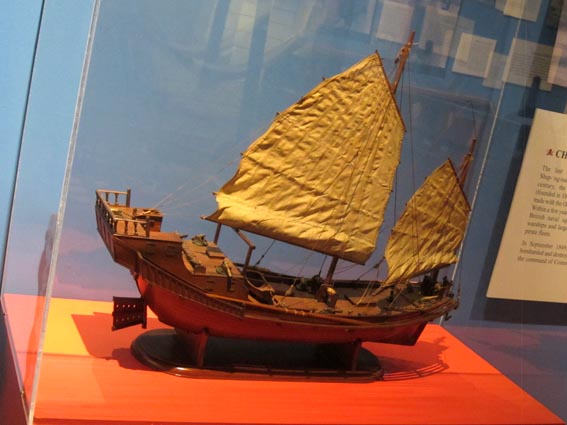
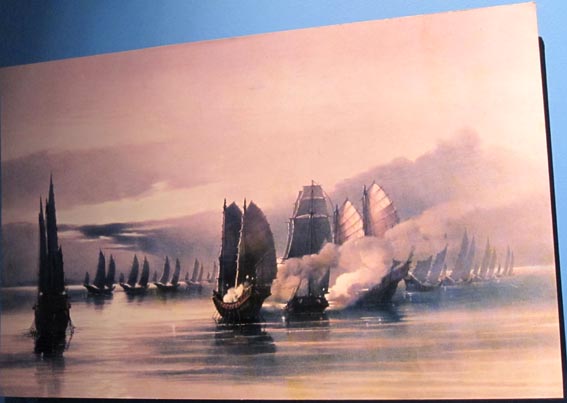
|
カナダのバンクーバー海洋博物館内に海賊展示コーナーがある。世界海賊史にその名を残す海賊ヘンリー・モーガン、女海賊アン・ボニーや
メアリー・リード、キャプテン・キッド、「黒ひげ (Blackbeard)」の異名をもつエドワード・ティーチなどの他、回教徒の海賊、南シナ海など
で荒らし回った中国人・日本人海賊などについて俯瞰している。画像は、同館に展示される、南シナ海を荒らし回った海賊ジャンク船の模型と
絵画である。パネルには次のような説明文が綴られている。
Piracy flourished in Asian waters as well as in other parts of the world. Because of the differences in language, the exploits of most of these pirates are not well known. Chinese and Japanese pirates began to maraud the sea and each other's coasts as far back as AD 400, and in the early 16th century, Japanese pirates sailed as far south as the Straits of Malacca (between Sumatra and Malaysia). Between the 17th and 19th centuries, great fleets of pirate junks, commanded by great Chinese pirate dynasties devastated the region's shipping. The arrival of Europeans not only brought political instability, but also new weapons and new opportunities for plunder. They were joined by English and Dutch pirates venturing into the Straits of Malacca to attack Portuguese ships and seize Chinese junks. In 1605, Edward Mitchelbourne, an English privateer, seized a Chinese junk that had already been captured by Japanese pirates. The two pirate forces battled each other in a close fight that only ended when the last Japanese pirate was killed. Piracy also flourished in the archipelago of islands south of China in the Southeast Asia. Malay, Javanese, Bugis (from Sulawesi), Achin (from Sumatra) Balanini (from Sulu) and Ilanun (from Mindanao in the Philippines) pirates began to actively raid and plunder in the late 18th and early 19th centuries. They raided as far south as New Guinea and as far east as Burma. As European trade in the region increased, the British Government took action to suppress the pirates, and through the 1840s scores of pirates were killed. The English-born, "white Rajah" of the Indonesian Kingdom of Sarawak, James Brooke, took an active hand as well, and in 1862, his steamer Rainbow devasted the Ilanun. By then the great age of piracy in the South China Sea had ended, but pirate activity persisted, and continues to this day.
maraud: vt.,vi.[略奪のために]襲撃する. plunder: vt.,vi.[人々・場所]から略奪する、収奪する、分捕る/plunderage: n.略奪; [法]船上横領、横領船荷. suppress: vt.[反乱などを]抑圧・鎮圧・鎮定する. 概略は以下の通りである。海賊は世界のいろいろな海域で隆盛を極めたが、アシアの海でもそうであった。言語上の違いからアジアにおける ほとんどの海賊の功績などについてはよく知られていない。 中国人と日本人の海賊は、歴史を遡って見れば、紀元後400年から略奪のため海を荒らし回り、お互いの海岸を襲撃した。 そして、16世紀初期には、日本人海賊はマラッカ海峡(マレーシアとスマトラ島との間)の南方域まで進攻した。 17から19世紀にかけて、中国人海賊の名門一族によって指揮された、ジャンクの海賊大船団はアジア地域の海上交通を荒廃させてしまった。 西欧人の到来は、この地域に政治的不安定のみならず、新しい武器や略奪のための機会をもたらすにいたった。そして、 彼ら西欧人は、ポルトガル船を攻撃したり、中国人のジャンク船を捕獲するためにマラッカ海峡へ敢えて進攻してきた英国人とオランダ人の海賊 と合流するにいたった。 1605年、英国人海賊 Edward Mitchelbourneは、日本人海賊によって既に捕獲されていた中国人ジャンクを分捕った。 そして、両海賊軍団は互いに接近戦を繰り広げ、闘いは最後の日本人海賊が殺害されるまで終わらなかった。 海賊はまた東南アジアの中国南方に位置する群島域においても隆盛であった。マレー人、ジャワ人、ブギス人 (スラウェシから)、 アチン人 (スマトラから)、ブラニニ人 (スールーから)、イラヌン人 (ミンダナオから)の海賊らは、それらの地域に、18世紀後期から 19世紀初期にかけて活発に攻め入り、略奪を行なった。彼らはビルマ東方、ニューギニア南方方面へも攻め入った。 それらの地域での西欧人による交易が拡大するにつれ、英国政府は海賊を抑圧する行動をとり、1840年代を通して多数の海賊は殺害された。 インドネシアのサラワク王国の「白いラージャ」(ラージャとはマレーやジャワの酋長) であった、英国生まれの ジェームズ・ブルックは、同じく積極的に海賊を統制し、1862年には彼の蒸気船「レインボウ」をもってイラヌンをやり込めた。 南シナ海での海賊の黄金時代はその時までには終わりを告げていた。しかし、海賊活動は消滅することなく、現代まで続いている。
[2015.2.2-17 カナダ&キューバの旅/記 2015.3.18/画像出典: バンクーバー海洋博物館/博物館には小さいながら海賊展示
コーナーがある]
|
1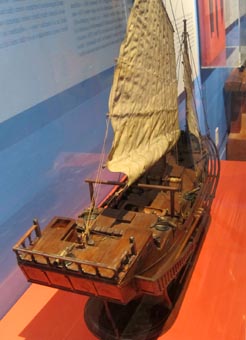 2 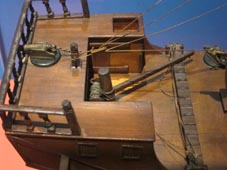 3 3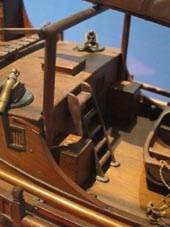 4 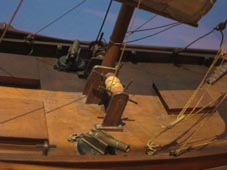 5 5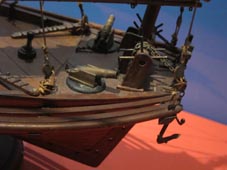 1. [拡大画像: x26630.jpg] 2. [拡大画像: x26631.jpg] 3. [拡大画像: x26632.jpg] 4. [拡大画像: x26633.jpg] 5. [拡大画像: x26634.jpg] |
Back to: Top Page |